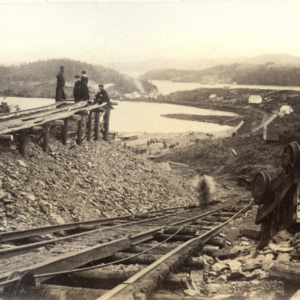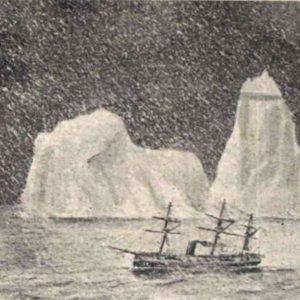![]()
![]()
 I keep learning more about historical mining in Newfoundland as I research Little Bay. I see a lot of ways it could be beneficial today. There are the obvious ways it contributes to Newfoundland heritage and tourism but I think there is untapped potential here for a method to assist current mining efforts, especially with prospecting. I further think we can find some insights into culture. Let’s consider Little Bay’s first mine manager – Mr. Adolph Guzman.
I keep learning more about historical mining in Newfoundland as I research Little Bay. I see a lot of ways it could be beneficial today. There are the obvious ways it contributes to Newfoundland heritage and tourism but I think there is untapped potential here for a method to assist current mining efforts, especially with prospecting. I further think we can find some insights into culture. Let’s consider Little Bay’s first mine manager – Mr. Adolph Guzman.
Adolph Guzman was born in Germany in 1839. At the age of 23 he followed his mentor, the Baron Franz von Ellershausen, to Nova Scotia to try his hand at gold. The following year Nova Scotia found 30 shipwrecked German families off its coast which would lead to the Baron creating the town of Ellershouse. He gave them a town with his own name on it! Around this time, 1864, Ellershausen and Guzman would learn of the freshly printed Geological Survey of Newfoundland. The Betts Cove deposit was discovered there by surveyor Robert Knight the following year.
Guzman and the Baron had their names on pattens by this time including one for improvements to the manufacturing of iron and steel. Guzman was living in New York in 1868 but back in Nova Scotia by 1872. The Baron had a house built for him. Ellershausen intended for his daughter to marry Guzman but she rejected him. He left, no doubt disheartened, to try his luck in Newfoundland. He got the Betts Cove claim off Robert Knight the following year.
Little Bay comes into this story in 1876 on October 14th when Adolph Guzman and Dr. Stirling together make a mining claim for the site of the future town. Around now we see the arrival of the characters most important to the early mining efforts on the island such as the Baron and Dr. Henry Eales. Eales is there to design the tramway.
The shipwrecked Germans became loyal miners for the Baron. They’d followed him to Newfoundland to work the new mine. Betts Cove was reported to be well ordered and tidy with no drinking or crime by visiting reverend Moses Harvey. This is the first we see of the designed culture found in these Newfie-German mining towns. They are mixed denominationally and focused on higher cultural pursuits like public hall performances. There’s an emphasis on literacy and polite language. And according to Harvey they’re quite sober. The claim by Harvey of no booze made me wonder about cultural enforcement as there doesn’t appear to be any official police there yet. The town is ran by the company in all facets. However, I can find court records of rum being stolen from Guzman and Eales which suggest the no drinking thing was likely class biased. I’ve also got records of Guzman being charged with imprisoning people. This suggests to me that the company ran nearly all the aspects of government including policing. It is noteworthy, however, that people could evidently appeal to the official but largely external other justice system.
 In 1878 Robert Colbourne found the Little Bay deposit. Guzman was out of town and so the Baron sent Dr. Eales to get it. Guzman and the Baron arrived the next day following good news from the good doctor. They got it off Colbourne for next to nothing and claimed it for themselves without putting Dr. Stirling’s name back on it. This little manoeuvre was gonna have consequences.
In 1878 Robert Colbourne found the Little Bay deposit. Guzman was out of town and so the Baron sent Dr. Eales to get it. Guzman and the Baron arrived the next day following good news from the good doctor. They got it off Colbourne for next to nothing and claimed it for themselves without putting Dr. Stirling’s name back on it. This little manoeuvre was gonna have consequences.
Throughout 1879 Guzman lived in Little Bay with the Baron at the Company Cottage in the Bight. It was described as a comfortable building. *It’s the nicest house in the picture by the wharf* Guzman took many ventures from the town prospecting for ores and developing shafts around the island. He mined a lot. A few don’t seem to be listed anywhere. Could whole mines be missing? Guzman’s prospecting is just one example. There’s a novel method to be found here. These people talked about mining all the time. Harvey describes a culture of prospectors with ore in their pockets and active opinions on the next big find. The lost mining records were not the only place these miner’s chatter was recorded. There’s information thought lost to the fire that can be found again. You just need to build a big enough database to tag their few references and put the information back together to narrow in. This can reveal location, composition, and/or production. A lot of the necessary archives for such work are already digitized online and many have key word search features. Guzman’s rank makes him a great example for this.
The Baron left Guzman in charge of the Little Bay mine as its manager. Guzman was praised for his efforts in the media. Credited with putting Newfoundland’s Northern mining region on the map, he was the one with the skills to do it and so he did it. This sudden boom in Newfoundland mining was expected to be a new dawn for the colony. The mine supported a town of miners with a purposefully designed culture. It faced challenges.
 In 1881 a major fire struck the town and mine manager Guzman responded admirably with the miners burying valuables, firefighting, and rebuilding what was lost afterwards. The operation was assisted by Captain Kennedy and the crew of the HMS Druid who were assigned with protecting the area from battleships near the French Shore. They helped Little Bay rebuild from the fire. Fire was a continuous and eventually final problem – hence the shortage of surviving paperwork.
In 1881 a major fire struck the town and mine manager Guzman responded admirably with the miners burying valuables, firefighting, and rebuilding what was lost afterwards. The operation was assisted by Captain Kennedy and the crew of the HMS Druid who were assigned with protecting the area from battleships near the French Shore. They helped Little Bay rebuild from the fire. Fire was a continuous and eventually final problem – hence the shortage of surviving paperwork.
In 1882 Dr. Stirling finally won his legal battle and had his name put back on Little Bay mine with the rest of the b’ys. No one was happy about this outcome. Both sides thought the other should have lost. The shared claim made for an uncomfortable compromise. Guzman left Newfoundland a short time later in 1883 rotted but wealthy. His last work in Newfoundland was sweeping the copper dust from the bottom of Stirling shaft which he sent to Little Bay for smelting. Adolph Guzman left our soggy island for the Arizona sun. Some report that he died there by way of murder but I’ve yet to confirm that. I can’t yet place the date of his death or find any gory details.
Today in Little Bay there is still land owned by Guzman due to some sort of infinity grant. This is unique and has been noticed by those with an interest in such legal-landy things. It’s the result of fancy political trickery. As I’ve addressed elsewhere – Premier Whiteway was the Baron’s lawyer and Governor Glover knew Dr. Eales from Africa. I think the choice to screw Dr. Stirling out of the Little Bay grant represents one of those moments where a single choice shapes history. Newfoundland could be a total different place if Guzman and the Baron had stayed and succeeded. Maybe I’m too forgiving but I can’t help but respect the raised standards of living, literacy, and emphasis on community building attempted with their designed culture. They had plans to connect the town by railway! I’d like to believe this was part of a plan for the town to survive the mine. Overall, I think they were trying to make something cool but using some shady methods to do it. You don’t name a town after yourself unless you’ve got ego attached to it. I think Guzman and the Baron were invested in Little Bay’s future. Maybe I’m wrong. Either way Little Bay’s train never came and the following management lacked such grand societal ambitions.
I’m based in Grand Falls-Windsor myself – near where Marathon Gold is now operating. I respect their efforts to hire locally and contribute to the local economy. I hope to see the mines continuing to contribute to our communities. Little Bay’s mining heritage is a tourism prospect worth supporting. There’s a lot to learn from Guzman and the Baron on what a mine can create and also how brief such resources last. It’s important to consider what they can help create while they’re active. Investing in community culture or heritage tourism offers something that can continue to give returns long after an industry departs. It’s beneficial both economically and socially to invest in the future while things are booming. That’s how everybody wins.
I’m happiest to see my work benefitting the town I’ve been researching for over half a decade. They’ve got a walking trail opening there soon that you should totally check out. August 12th will see Little Bay’s first Heritage Day so go visit! The mine that Guzman managed is once again contributing to Little Bay’s future.
My research has gotten more attention since mining took off in central. It got me pondering how social and archival research can contribute to industry. All that fancy training lets me think outside the box especially when I need to make research do something particular. I started to notice that the official record on the mine’s annual production had gaps in it. It makes sense as Little Bay mine’s records were lost to the fire. This includes the maps, a fact which contributed to the 1965 accident. The thing is though, I had some of these missing numbers. They were missing from every journal on mining or geology that addressed the region going back to 1935. I realized that no one had gone about connecting historical mining data the way I was doing it. I’m probably the first person to realize you could potentially find lost ore bodies by building and cross referencing a database of historical media to aid prospecting.
I contacted the CEO of one of the mining companies who was nice enough to have a couple of meetings with me. Mostly, I just let him know the numbers he was missing. I figure if I want community minded companies I should be willing to give them a hand first. They can have a lot to offer our communities if so motivated. I seek to appeal to our better natures I guess. Heritage and tourism should certainly be at the front of their contribution to our community’s futures, but further than that, I think my work offers solid evidence of the under utilized prospects that can be offered by under employed arts degree grads. There are so many skills underused because we’re limited in how we think of job roles. Just think about how many trained sociologists with stats, archival, and social research skills are employed in unrelated fields when they could be coming up with novel approaches to industry like this. I assume the other disciplines got skills I don’t even know about. It seems like culture could use method to me. Guzman offers us insight on cultural design – there’s method to be mined.
History gives us lots to think about.
I’m hoping this reaches someone with Adolph Guzman’s picture. If you wanna help give it a share, luh.
Thanks for reading!
References:
- 1839 – Born in Germany (Arizona records)
- 1862 – The Baron left Germany for Nova Scotia (Bassler) *Likely left at the same time at age 23*
- 1864 – Geological Survey of Newfoundland (Bassler)
- 1868 – Adolph Guzman is on Ellershausen’s patten for improving the manufacturing of iron and steel. Guzman is listed as being from New York at this time (Engineering magazine)
- 1872 – Baron Ellershausen built a home for Guzman thinking that he’d marry his daughter but she rejected him so he fled to Newfoundland (Martin)
- 1876, Oct 14 – Adolph Guzman and Dr. Stirling file the first claim for Little Bay (Martin)
- 1877 – Rum belonging to him and Dr. Eales is stolen (Supreme Court docs)
- 1878 – Guzman was absent when the Baron learned of Colbourne’s discovery of copper at Little Bay and so dispensed Dr. Eales. Eales returns with Guzman and the Baron (Howley)
- 1879, March – Mill Manager Guzman was selected chairman of the building committee to oversee the construction of a church (Moncrief)
- 1879, May 3 – Rev. Gunn was living with Baron Ellershausen and Mr. Guzman in Little Bay (The Witness)
- 1879, June 2 – William Bonner was charged with assaulting and doing injury to Adolphe Guzman (SJP& )
- 1879, Sept 20 – Prospecting in Harbour Main (HGS)
- 1879, Sept 20 – L.G. MacNeil visited Little Bay and described Guzman’s cottage as comfortable. Rev. Gunn was still staying there with him (HGS)
- 1879, Dec 10 – In court for wrongful imprisonment. The court heard Brine vs Guzman for damages. (SJTNA&PO, HGS)
- 1879 – He is in court several times related to the wrongful imprisonment of Teresa Brien and the assault by William Bonner (Supreme Court docs)
- 1880, May 13 – Mr. Guzman had plans to open a mine at Seal Bay near Leading Tickle (CH)
- 1880, June 5 – Rev. Gunn reflects on the kindness shown him by the Baron and Mr. Guzman (The Witness)
- 1880, June 19 – Departure gift given to Rev. Gunn (HGS)
- 1880, July 17 – Mr. Guzman sent a team from Little Bay to Conception Harbour to check out a find of horse-flesh copper. This he leased from Mr. Nowlan (HGS)
- 1880, July 8 – Mr. Guzman was overseeing experimental operations at Whale’s Back mine (ET, TS)
- 1880, July 24 – Mr. Guzman travelled from St. John’s to Little Bay on the Plover with Dr. Stafford (TS)
- 1880, Sept 2 – Visited Twillingate by steamer (TS)
- 1880, Nov 18 – News paper recognizes that it is due to Mr. Guzman that people are aware of the northern mining district (TS)
- 1881, Feb 1 – Copper discovered on Guzman’s claim in South West Arm (ET, HGS)
- 1881, May 5 – Guzman offering reward for missing spars (TS)
- 1881, July 6 – Guzman and Captain Kennedy thanked for their help with fire (HGS, TS)
- 1881, Sept 3 – Guzman took Captain Kennedy on a tour of the mine (HGS)
- 1882, May 17 – fee-simple grant (Martin)
- 1882 – “When the final ore shipment left the Sterling mine in 1882, Adolph Guzman had miners sweep the copper dust from the bottom of the shaft and place it in canvas bags to be taken to Little Bay. This was probably the last Newfoundland mining job supervised by Guzman. He left the Island around 1883 for the United Sates and subsequently was murdered in Arizona” (Martin)
- 1896 – Appears on the voter’s list for Arizona with birth listed as 1839 in Germany (Arizona voting records)
